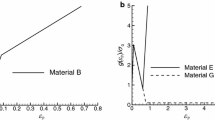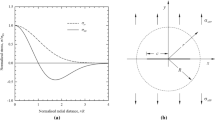Abstract
A general method for simulating on a computer the growth of the cone-shaped fracture that forms under Hertzian contact loading is outlined. The program involves an incrementing procedure in which both contact circle and cone crack are grown in piecewise manner, according to suitable rate equations. The contact circle expands at a rate determined by the mode of indenter loading, and thereby sets up a time-varying stress field. Appropriate fracture-mechanics criteria are then invoked to calculate the response of the growing crack to the contact stresses. Effects of loading mode, specimen environment and temperature, size and location of the initial flaw from which the cone crack nucleates, are investigated systematically. The computer predictions compare favourably with available experimental data. The results are discussed in the light of previous theoretical treatments of the Hertzian fracture problem, and some new features in the crack-growth characteristics are pointed out. Calculations are made specifically for normal contact loading on glass, but ready extension of the program to other loading situations and materials in envisaged.
Résumé
On traite d'une méthode générale de simulation sur calculateur de l'extension d'une rupture en forme de cône, telle qu'il s'en présente lors de mises en charge par contact Hertzien.
Le programme comporte une procédure par incréments, où l'on accroît par pliers le cercle de contact et la fissure conique, en se référant à des équations décrivant adéquatement cette croissance.
La vitesse d'expansion du cercle de contact dépend du mode de mise en charge de l'indentation; elle entraîne la création d'un champ de contraintes variables dans le temps. Les critères appropriés de la mécanique de rupture peuvent alors être invoqués pour calculer la relation lian la dimension de la fissure aux contraintes de contact. On a étudié de manière systématique les effets du mode de sollicitation, de l'environnement et de la température de l'éprouvette, de la dimension et de l'emplacement du défaut initial à partir duquel se forme la fissure conique. Les prédictions fournies par le calculateur s'accordent bien aux données expérimentales disponibles.
Les résultats sont discutés à la lumière des développements théoriques qui ont déjà été consacrés précédemment au problèmes de la rupture sous contact Hertzien, et font ressortir des connaissances nouvelles sur les caractéristiques d'extension de ce type de fissures.
En principe, les calculs ont été effectués dans le cas d'une charge normale à une surface de verre, mais on envisage dès à présent une extension du programme à d'autres conditions de charge et à d'autres matériaux.
Zusammenfassung
Man behandelt ein allgemeines Komputerverfahren zur Simulation der Ausbreitung eines konischen Bruches unter hertzischer Kontaktbelastung. Das Programm enthält ein Inkrementverfahren in dem sowohl der Kontaktkreis wie der konische Riß stufenweise erwachsen, in übereinstimmung mit annehmbaren Ausbreitungsgeschwindigkeitsgleichungen. Der Kontaktkreis hat eine Ausbreitungsgeschwindigkeit die von der Einzahnungsbelastung abhängt, und führt dadurch ein zeitlich veränderliches Spannungsfeld ein.
Dann werden passende Bruchmechanikskriterien angewandt um den Zusammenhang zwischen der Rißausbreitung und der Kontaktspannungen zu rechnen. Einflüsse des Belastungsverfahren, Umgebung und Temperatur des Prüfstabes, Größe und Lage des Anfangsfehlers von dem der konische Riß ausgeht, werden systematisch untersucht. Die Voraussagungen des Komputers sind günstig vergleichbar mit den Versuchsergebnissen.
Man bespricht die Resultate im Rahmen von bestehenden theoretischen Lösungen des Hertzischen Bruchproblems, und einige neue Gesichtspunkte in den Rißausbreitungsbegebenheiten werden hervorgehoben.
Die Rechnungen wurden besonders für normale Kontaktbelastung auf Glass aufgestellt, aber schon jetzt werden Ausdehnungen des Verfahrens für andere Belastungen und andere Werkstoffe in Betracht gezogen.
Similar content being viewed by others
References
H. Hertz,Hertz's Miscellaneous Papers, Chs. 5 and 6. (MacMillan, London, 1896).
M. T. Huber,Ann. Physik, 14 (1904) 153.
F. C. Frank and B. R. Lawn,Proc. Roy. Soc., A299 (1967) 291.
B. R. Lawn,J. Appl. Phys., 39 (1968) 4828.
F. B. Langitan and B. R. Lawn,J. Appl. Phys., 40 (1969) 4009.
F. B. Langitan and B. R. Lawn,J. Appl. Phys., 41 (1970) 3357.
T. R. Wilshaw,J. Phys. D. Appl. Phys., 4 (1971) 1567.
J. Heavens, unpublished work.
J. J. H. Beek and B. R. Lawn,J. Phys. E. Scientific Instrum., in press.
von H. Rumpf and K. Schönert, Third European Symposium on Comminution, Cannes, France, Oct. 5–8, 1971, p. 27–56. Dechema Frankfurt; Verlag Chemie Weinheim.
A. G. Mikosza and B. R. Lawn,J. Appl. Phys., 42(1971) 5540.
The stress-intensity factor defined here differs by a factor of √π from that used in some other papers.
A. A. Griffith,Phil. Trans., A221, (1920) 163.
S. M. Wiederhorn and L. H. Bolz,J. Amer. Ceram. Soc., 53 (1970) 543.
K. Schönert, H. Umhauer and W. Klemm,Fracture, Proceedings of Second International Conference, Brighton, 1969, paper 41.
F. Kerkhof and H. Richter,Fracture, Proceedings of Second International Conference, Brighton, 1969, paper 40.
A. G. Mikosza, J. J. H. Beek and M. V. Swain, unpublished work.
F. P. Mallinder and B. A. Proctor,Phys. and Chem. Glasses, 5 (1964) 91.
P. B. Withers, unpublished work.
G. M. Hamilton and L. E. Goodman,J. Appl. Mech., 33 (1966) 371.
B. R. Lawn,Proc. Roy. Soc., A299 (1967) 307.
N. E. W. Hartley, Ph. D. thesis, University of Sussex, 1971.
Author information
Authors and Affiliations
Rights and permissions
About this article
Cite this article
Lawn, B.R., Wilshaw, T.R. & Hartley, N.E.W. A computer simulation study of Hertzian cone crack growth. Int J Fract 10, 1–16 (1974). https://doi.org/10.1007/BF00955075
Received:
Issue Date:
DOI: https://doi.org/10.1007/BF00955075




